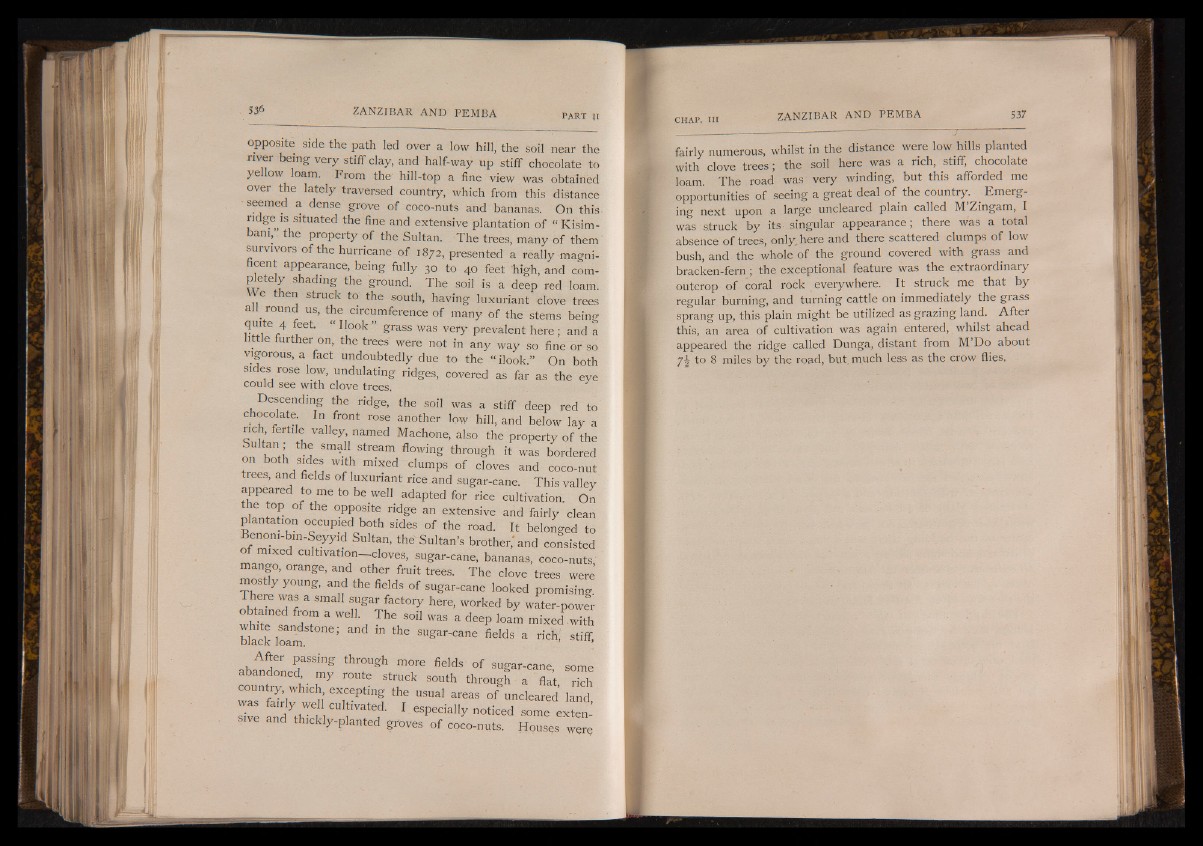
opposite side the path led over a low hill, the soil near the
river being very stiff clay, and half-way up stiff chocolate to
yellow loam. From the hill-top a fine view was obtained
over the lately traversed country, which from this distance
seemed a dense grove of coco-nuts and bananas. On this
ridge is situated the fine and extensive plantation of | Kisim-
batn, the property of the Sultan. The trees, many of them
survivors of the hurricane of 1872, presented a really magnificent
appearance, being fully 30 to 40 feet high, and completely
shading the ground. The soil is a deep red loam.
We then struck to the south, having luxuriant clove trees
all round us, the circumference of many of the stems being
quite 4 feet. | Ilook I grass was very prevalent here; and a
little further on, the trees were not in any way so fine or so
vigorous, a fact undoubtedly due to the “ ilook.” On both
sides rose low, undulating ridges, covered as far as the eye
could see with clove trees.
Descending the ridge, the soil was a stiff deep red to
chocolate. In front rose another low hill, and below lay a
rich fertile valley, named Machone, also the property of the
U w k I Sm\11 Stream flowin§' through it was bordered
W1r i mixed clumpS of cIoves and coco-nut
trees, and fields of luxuriant rice and sugar-cane. This valley
appeared to me to be well adapted for rice cultivation. On
the top of the opposite ridge an extensive and fairly clean
plantation occupied both sides of the road. It belonged to
Benoni-bin-Seyyid Sultan, the Sultan's brother,'and consisted
of mixed cultivation .cloves, sugar-cane, bananas, coco-nuts
mango, orange, and other fruit trees. The clove trees were
mostly young, and the fields of sugar-cane looked promising
There was a small sugar factory here, worked by water-power
obtained from a well. The soil was a deep loam mixed wTth
black W . ' ¡ J f i f fields a H stiff,
, A ^Cr paSsing throu£h more fields of sugar-cane, some
bandoned my route struck south through a flat, rich
country, which, excepting the usual areas of uncleared land
was fa,rly „ d l cultivated. I especial.y „ „ f e d some e S
and th''Wy-P'anted groves of coco-nuts. Houses were
fairly numerous, whilst in the distance were low hills planted
with clove trees; the soil here was a rich, stiff, chocolate
loam. The road was very winding, but this afforded me
opportunities of seeing a great deal of the country, j Emerging
next upon a large uncleared plain called M Zingam, I
was struck by its ■ singular appearance, there was a total
absehce of trees, only, here and there scattered clumps of low
bush, and the whole of the ground covered with grass and
bracken-fern j the exceptional feature was the extraordinary
outcrop of coral rock everywhere. It struck me that by
regular burning, and turning cattle on immediately the grass
sprang up, this plain might be utilized as grazing land. After
this, an area of cultivation was again entered, whilst ahead
appeared the ridge called Dunga, distant from M’Do about
7 J to 8 miles by the road, but. much less as the crow flies.